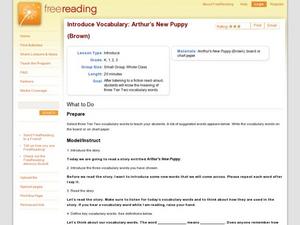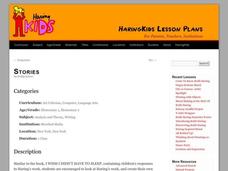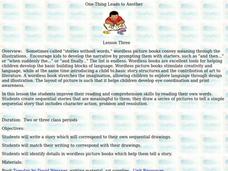Baylor College
Food for the Brain
With a couple of neat diagrams on student handouts, your life science or health class will examine the contents and serving sizes of healthy foods. They dissect a slice of pizza and scrutinize the nutritional value of its components in...
Curated OER
Clowning Around: Drawing
Kids create a clown out of shapes. They work to show emotions while practicing their drawing skills. Pupils use circles, triangles, squares, oil pastels, and their imagination to draw, color, and decorate a sad or happy clown. Tip: Have...
Curated OER
Manners and Mores of Washington's America
Learners explore the social policies of early America. In this etiquette lesson, students read George Washington's "110 Rules of Civility and Decent Behavior in Company and Conversation." Learners identify expectations for their own...
Baylor College
Microbes and Disease
Discuss how diseases have impacted human history. Divide your class into groups and assign each group one of the following: tuberculosis, malaria, plague, cholera, smallpox, and AIDS. They read up on, complete a concept map, and present...
Curated OER
Sharing My Older Friend With Others
Elementary learners explore the difference between aged characters and young characters in literature. They use Venn diagrams to compare and contrast the attributes given to both younger and older characters in different pieces of...
Curated OER
Introduce Vocabulary: Arthur's New Puppy (Brown)
Learn new words as you read Marc Brown's story, Arthur's New Puppy. This is focused as a vocabulary-in-context activity (though this strategy could be used with any book and set of words). Introduce the new words you will focus on:...
Curated OER
Introduce Vocabulary: Dinosaur Bones (Barner)
Dig into some prehistoric vocabulary in Bob Barner's informative book Dinosaur Bones. This works best if you introduce the primitive words before reading the story. These are the focus terms in the text: ancient, climate, extinct,...
Curated OER
Bud, Not Buddy: Directed Reading Thinking Activity
Here’s a reading strategy that can be used with any text. Class members examine portions of a novel, and make predictions about the theme or subject matter of the book. Although designed for Christopher Paul Curtis’s Newbery Medal...
BioEd Online
Muscles and Bones in Space
Being an astronaut takes not only high mental acuity, but also a high level of physical fitness, especially for those who spend a long amount of time away from Earth, such as the astronauts serving on the International Space Station....
Baylor College
Energy for Life (Energy from Food)
Energy comes in many forms, but how do living things get the energy they need to survive and thrive? In a simple, controlled experiment with yeast, water, and sugar, groups make observations about how yeast reacts with water alone, then...
Curated OER
Folktale Unit: The Princess and the Golden Shoes
Students study variations of classic folktales while deciding why the tales were so popular many years ago. They write a letter to an author.
Curated OER
ESL Lesson Plan
Students listen to a story and comprehend, in a manner of writing down the story sentence by sentence, possibly in the exact words. They read their own writings to others and make them understand.
Curated OER
Stories
Students examine the book, I Wish I Didn't Have to Sleep, and examine Haring's work. They create stories about Keith Haring's pictures.
Curated OER
Finding My Hat
Sixth graders explore the Korean culture through the book, Finding My Hat. They read and discuss the book in literature circles and write in response journals after each chapter. Comparing the main character to themselves, they note the...
Curated OER
Georgia Performance Standards Framework for ELA Unit 6-8th grade
Eighth graders explore figurative language through the study of picture books. In this figurative language activity, 8th graders listen to books and chart the figurative language that they hear. Students discuss examples in groups.
Curated OER
Stick To The Topic
Second graders engage in a lesson that is concerned with the increase of writing conventions. The teacher models the writing process for the students. The students work with the teacher to create a shared writing piece before the work...
Curated OER
What Does Christmas Mean to Me?
Students write an essay entitled "What Does Christmas Mean to Me?" In this writing lesson, students express their feelings about Christmas in an essay. Students discuss ways they have given to others during the Christmas season, then...
Curated OER
A Photo Essay
Students create a photo essay and present it to the class. The students bring photos to use for their essay and develop a story using the photos. The students write captions including characters, setting, and plot for each photo. They...
Curated OER
The Littlest Matryoshka
Students listen to the story The Littlest Matryoshka and sequence the story. In this sequencing lesson plan, students sequence the story and also make little dolls based on the story and write stories about them.
Curated OER
Predictable Chart/Sentence Building with "Goodnight Moon"
First graders work on a series of modeled reading and writing lessons based on "Goodnight Moon." students work on pages of a predictable class book.
Curated OER
One Thing Leads to Another
Students analyze the storytelling methods in wordless books. In this visual storytelling lesson, students write a story that correspond to a specific wordless picture book. Students create their own wordless picture book...
Curated OER
Ten
Students create their own counting book and brainstorm ideas with each other for a concept. In this counting lesson plan, students first read books such as Ten by Keith Haring.
Curated OER
Activity Plan 3-4: Let's Find Signs!
Students develop early reading skills as they explore signs and their meanings. In this early childhood lesson plan, students identify various signs and their meanings. Students use laminated signs as manipulatives in matching and...
Curated OER
Polar Bear, Polar Bear, What Do You Hear? Lesson Plan
Young scholars use technology and listening skills to explore the sounds of their environment. In this environment observation lesson, students read Polar Bear, Polar Bear, What Do You Hear? in order to identify the sounds in the story;...























